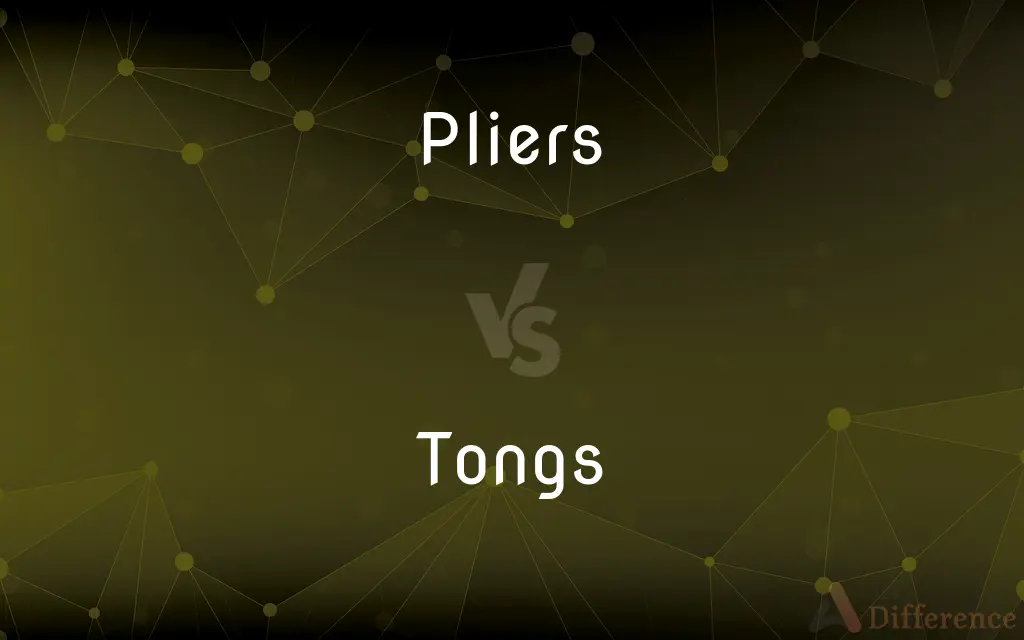Pliers vs. Tongs — What's the Difference?
Edited by Tayyaba Rehman — By Fiza Rafique — Updated on March 11, 2024
Pliers are designed for gripping small objects with precision, while tongs are made for grasping and lifting hot or large items safely.

Difference Between Pliers and Tongs
Table of Contents
ADVERTISEMENT
Key Differences
Pliers are a versatile tool used primarily in electrical and mechanical work for gripping, bending, and cutting small objects, often featuring a pivot point that increases force. They come in various designs like needle-nose and wire cutters, tailored for specific tasks, and are operated by compressing their handles, which allows for precise manipulation of small items. On the other hand, tongs are designed for holding and manipulating larger objects, particularly in cooking and blacksmithing, to provide safety from heat or to handle food. They consist of two arms connected at one end, usually with a mechanism to keep them open until squeezed closed, and their design varies from kitchen tongs for food to heavy-duty versions for forging and laboratory use.
Pliers offer a mechanical advantage, making them ideal for tasks that require precision and force on small items. Their design allows for the exertion of significant force with minimal effort, enabling the manipulation of tiny, stubborn, or tightly fitted parts. Tongs, conversely, are optimized for safety and efficiency in handling hot or cumbersome items, with their long handles and materials like wood or silicone for kitchen use, or metal for high-temperature environments, providing insulation from heat and a secure grip.
While pliers are an essential tool in detailed mechanical and electrical work for their ability to cut, bend, and grip with precision, tongs are indispensable in kitchens and forges for their utility in safely managing items that are too hot, too large, or otherwise impractical to handle directly. This distinction highlights the specialized functions these tools serve in different settings.
Both pliers and tongs are critical in their respective fields, with the choice between them depending on the task at hand. Pliers are a staple in toolboxes for intricate tasks requiring detailed manipulation, whereas tongs are a kitchen and forge essential, reflecting the diverse applications of these fundamental tools.
Comparison Chart
Primary Use
Gripping, bending, and cutting small objects
Grasping and lifting hot or large items
ADVERTISEMENT
Operation
Operated by compressing handles
Squeezed to close around an object
Design Variants
Needle-nose, wire cutters, etc.
Kitchen, blacksmithing, laboratory tongs
Material
Metal with insulated grips for safety
Metal, wood, silicone depending on use
Ideal For
Electrical and mechanical work
Cooking, blacksmithing, handling hot items
Compare with Definitions
Pliers
Pliers can have various jaw designs for specific tasks.
The jeweler used flat-nose pliers to bend the delicate metal.
Tongs
A tool used for gripping and lifting items, often in cooking.
She used tongs to flip the steak on the grill.
Pliers
A hand tool used for holding, bending, or cutting small objects.
He used pliers to twist the wire into place.
Tongs
Tongs can be made of metal, wood, or silicone, depending on their use.
He used silicone tongs to serve the salad.
Pliers
Pliers often come with insulated handles for electrical work.
She grabbed the insulated pliers to work on the live circuit.
Tongs
Some tongs have a locking mechanism for easy storage.
She locked the tongs and stored them in the drawer.
Pliers
Some pliers include a cutting edge for wire.
Using the cutting pliers, she trimmed the excess wire.
Tongs
Long-handled tongs provide safety from heat.
Using long-handled tongs, she safely removed the baking sheet from the oven.
Pliers
Needle-nose pliers are ideal for reaching into tight spaces.
He used needle-nose pliers to retrieve the small screw.
Tongs
Tongs are essential in blacksmithing for handling hot metal.
The blacksmith grabbed the hot iron with his heavy-duty tongs.
Pliers
Pliers are a hand tool used to hold objects firmly, possibly developed from tongs used to handle hot metal in Bronze Age Europe. They are also useful for bending and compressing a wide range of materials.
Tongs
Tongs are a type of tool used to grip and lift objects instead of holding them directly with hands. There are many forms of tongs adapted to their specific use.
Pliers
Pincers with parallel, flat, and typically serrated surfaces, used chiefly for gripping small objects or bending wire
A pair of pliers
Tongs
An instrument or tool used for picking things up without touching them with the hands or fingers, consisting of two slats or grips hinged at the end or in the middle, and sometimes including a spring to open the grips.
Pliers
One who plies a trade.
Tongs
(by extension) A large scissors-like two-piece center-hinged forged-iron implement with oval-loop handles and with pointed tips turned inward (in the same plane as and perpendicular to the handles) to facilitate lifting and carrying a block of ice. Often called ice tongs.
Pliers
Pliers A variously shaped hand tool having a pair of pivoted jaws, used for holding, bending, or cutting.
Tongs
An instrument, usually of metal, consisting of two parts, or long shafts, jointed together at or near one end, or united by an elastic bow, used for handling things, especially hot coals or metals; - often called a pair of tongs.
Pliers
A pincer-like gripping tool that multiplies the strength of the user's hand, often used for bending things.
I need a pair of pliers to get a good grip on that broken screw.
Tongs
Any of various devices for taking hold of objects; usually have two hinged legs with handles above and pointed hooks below
Pliers
A kind of small pinchers with long jaws, - used for bending or cutting metal rods or wire, for handling small objects such as the parts of a watch, etc.
Pliers
A gripping hand tool with two hinged arms and (usually) serrated jaws
Common Curiosities
Are there different types of tongs?
Yes, there are kitchen tongs, blacksmithing tongs, and others designed for specific tasks.
Do all pliers have insulated handles?
Not all, but many have insulated handles for electrical work safety.
Can tongs be used in cooking only?
No, tongs are used in cooking, blacksmithing, and for handling hot items in various settings.
Are needle-nose pliers a type of pliers?
Yes, needle-nose pliers are a type designed for precision work in tight spaces.
What are pliers used for?
Pliers are used for gripping, bending, and cutting small objects with precision.
Can pliers cut wire?
Yes, some pliers have a cutting edge designed specifically for cutting wire.
What are the benefits of silicone tongs in the kitchen?
Silicone tongs are gentle on cookware and heat resistant, making them ideal for kitchen use.
What makes pliers ideal for electrical work?
Their precision grip and sometimes insulated handles make them safe and effective for electrical tasks.
Is there a locking mechanism on tongs?
Some tongs feature a locking mechanism for compact storage.
How do tongs differ from pliers in operation?
Tongs are usually operated by squeezing them closed, while pliers require compression of the handles for gripping.
Can tongs be made of silicone?
Yes, silicone tongs are common for kitchen use to handle food safely.
Can pliers be used for mechanical work?
Yes, pliers are essential tools for various mechanical tasks requiring gripping and manipulation of small parts.
What safety features might tongs have for blacksmithing?
Blacksmithing tongs are made of durable materials with long handles to protect from heat.
Why do tongs have long handles?
Long handles provide safety from heat when handling hot items or cooking.
How do the materials of pliers and tongs differ for their uses?
Pliers are typically made of metal with rubber or plastic grips for safety, while tongs can be metal, wood, or silicone, depending on their intended use.
Share Your Discovery

Previous Comparison
Acacia vs. Tragacanth
Next Comparison
Embark vs. EmbraceAuthor Spotlight
Written by
Fiza RafiqueFiza Rafique is a skilled content writer at AskDifference.com, where she meticulously refines and enhances written pieces. Drawing from her vast editorial expertise, Fiza ensures clarity, accuracy, and precision in every article. Passionate about language, she continually seeks to elevate the quality of content for readers worldwide.
Edited by
Tayyaba RehmanTayyaba Rehman is a distinguished writer, currently serving as a primary contributor to askdifference.com. As a researcher in semantics and etymology, Tayyaba's passion for the complexity of languages and their distinctions has found a perfect home on the platform. Tayyaba delves into the intricacies of language, distinguishing between commonly confused words and phrases, thereby providing clarity for readers worldwide.














































